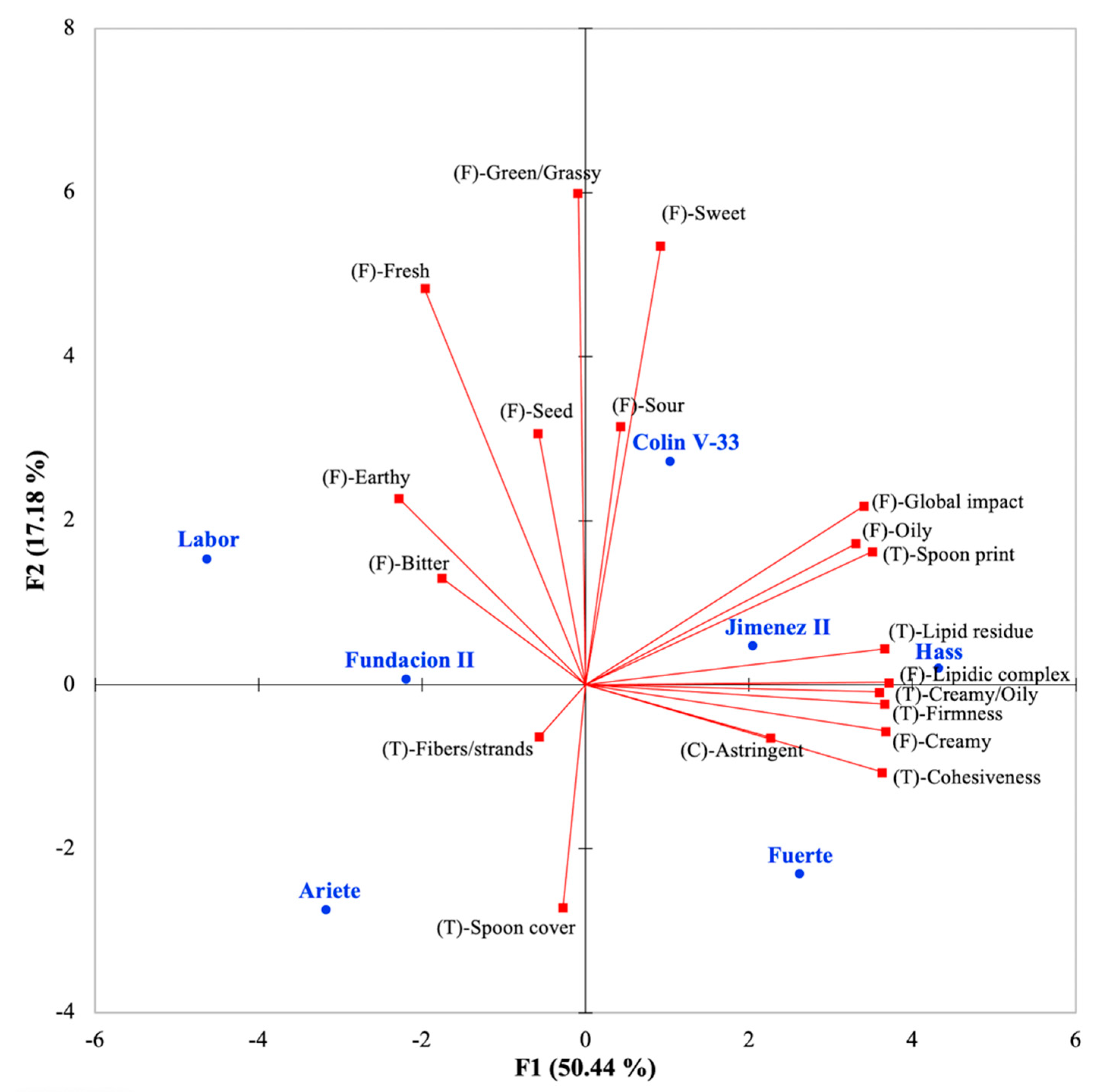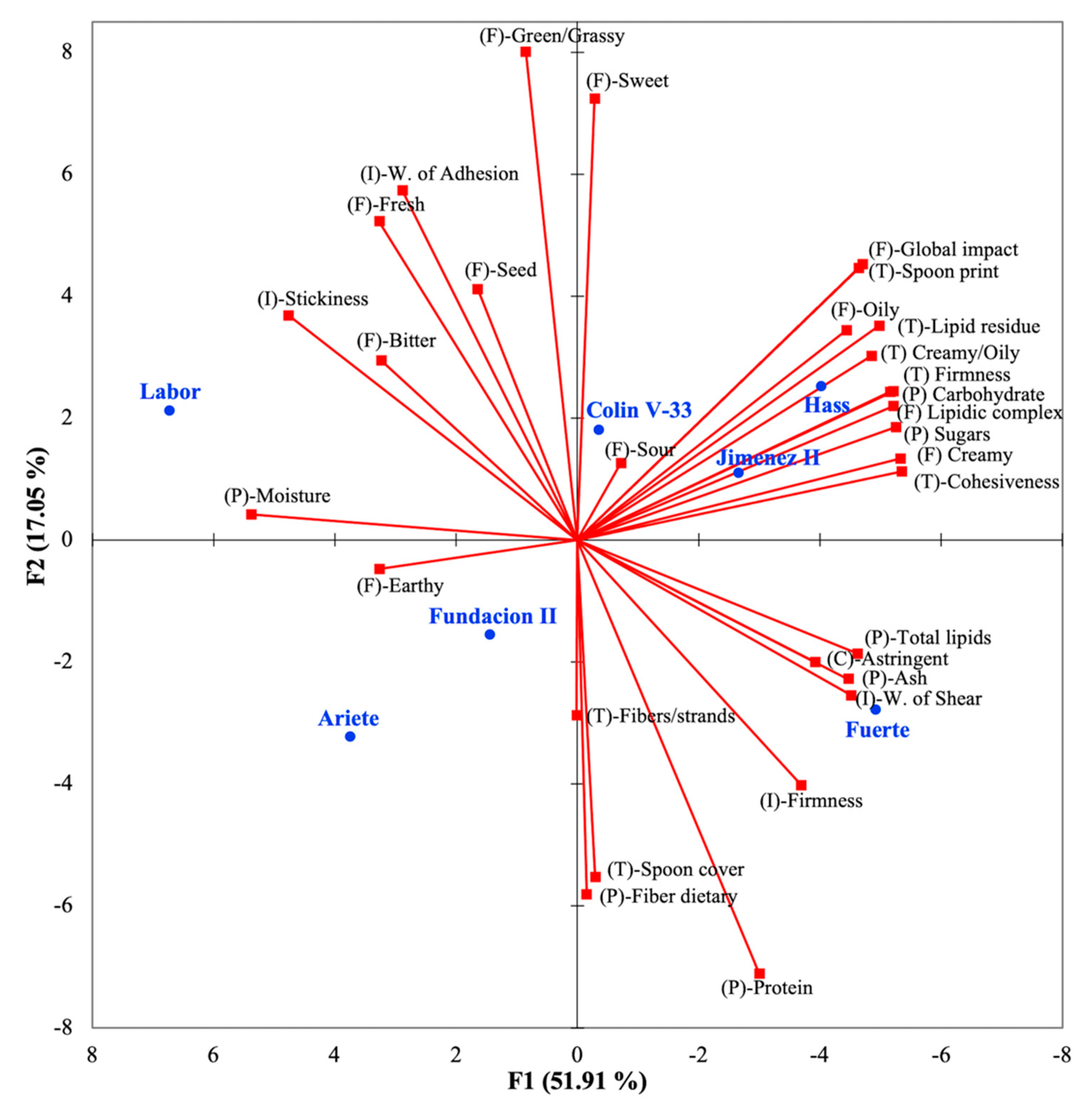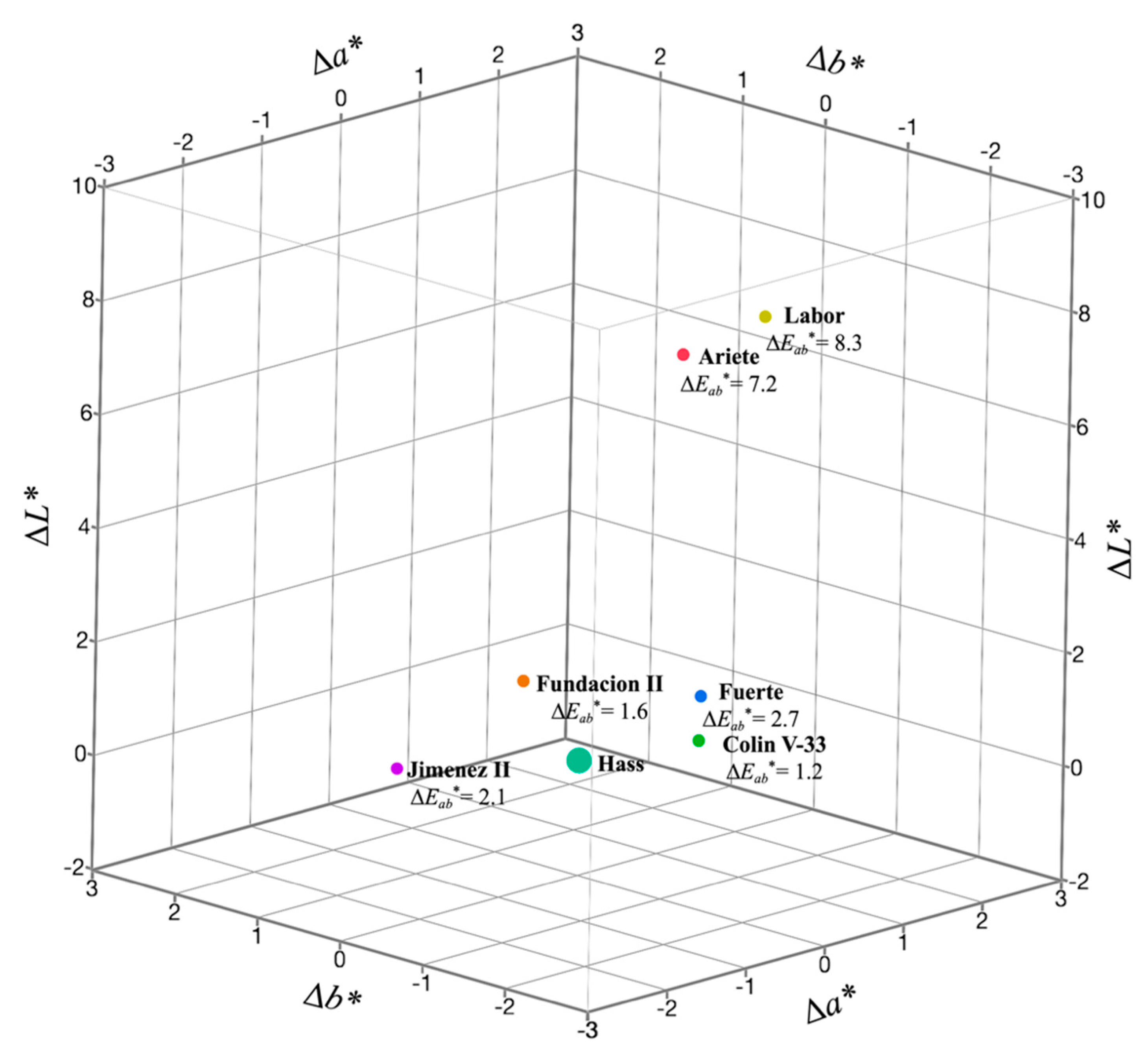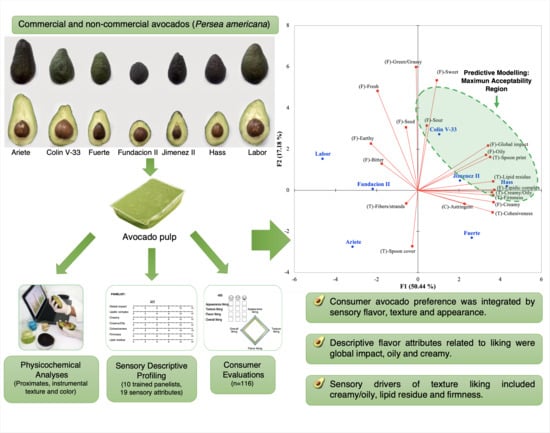Insights into Drivers of Liking for Avocado Pulp (Persea americana): Integration of Descriptive Variables and Predictive Modeling
Abstract
1. Introduction
2. Materials and Methods
2.1. Plant Material
2.2. Physicochemical Analyses
2.2.1. Proximate Macronutrient Composition
2.2.2. Instrumental Texture Analyses
2.2.3. Instrumental Color Determinations
2.3. Sensory Analyses
2.3.1. Sample Preparation
2.3.2. Sensory Descriptive Profiling
2.3.3. Consumer Evaluations
2.4. Statistical Analysis
3. Results
3.1. Fruit Morphological Traits and Proximate Macronutrient Composition
3.2. Descriptive Sensory Analyses of Avocado Pulps
3.3. Liking of Avocado Pulps by Consumers
3.4. Preference Mapping of Consumer Acceptability and Descriptive Sensory Attributes
3.5. Proximate Macronutrient, Instrumental Texture, Instrumental Color, and Sensory Relationships
4. Discussion
4.1. Fruit Morphological Traits and Proximate Macronutrient Composition
4.2. Descriptive Sensory Analyses of Avocado Pulps
4.3. Preference Mapping of Consumer Acceptability and Descriptive Sensory Attributes
4.4. Proximate Macronutrient, Instrumental Texture, Instrumental Color, and Sensory Relationships
5. Conclusions
Supplementary Materials
Author Contributions
Funding
Institutional Review Board Statement
Informed Consent Statement
Data Availability Statement
Acknowledgments
Conflicts of Interest
References
- Pedreschi, R.; Uarrota, V.; Fuentealba, C.; Alvaro, J.E.; Olmedo, P.; Defilippi, B.G.; Meneses, C.; Campos-Vargas, R. Primary metabolism in avocado fruit. Front. Plant Sci. 2019, 10, 795. [Google Scholar] [CrossRef] [PubMed]
- Rendón-Anaya, M.; Ibarra-Laclette, E.; Méndez-Bravo, A.; Lan, T.; Zheng, C.; Carretero-Paulet, L.; Perez-Torres, C.A.; Chacón-López, A.; Hernandez-Guzmán, G.; Chang, T.H.; et al. The avocado genome informs deep angiosperm phylogeny, highlights introgressive hybridization, and reveals pathogen-influenced gene space adaptation. Proc. Natl. Acad. Sci. USA 2019, 116, 17081–17089. [Google Scholar] [CrossRef] [PubMed]
- FAOSTAT Avocado: Production-Crops. Available online: http://www.fao.org/faostat/en/ (accessed on 22 September 2020).
- Dreher, M.L.; Davenport, A.J. Hass Avocado Composition and Potential Health Effects. Crit. Rev. Food Sci. Nutr. 2013, 53, 738–750. [Google Scholar] [CrossRef] [PubMed]
- Duque, A.M.R.; Londoño-Londoño, J.; Álvarez, D.G.; Paz, Y.B.; Salazar, B.L.C. Comparison of the oil from Hass variety avocado cultivated in Colombia, obtained by supercritical fluids and by conventional methods: A perspective under quality terms. Rev. Lasallista Investig. 2013, 9, 151–161. [Google Scholar]
- Farines, M.; Soulier, J.; Rancurel, A.; Montaudoin, M.G.; Leborgne, L. Influence of avocado oil processing on the nature of some unsaponifiable constituents. J. Am. Oil Chem. Soc. 1995, 72, 473–476. [Google Scholar] [CrossRef]
- Ding, H.; Chin, Y.W.; Kinghorn, A.D.; D’Ambrosio, S.M. Chemopreventive characteristics of avocado fruit. Semin. Cancer Biol. 2007, 17, 386–394. [Google Scholar] [CrossRef]
- Jacobo-Velázquez, D.A.; Hernández-Brenes, C. Stability of avocado paste carotenoids as affected by high hydrostatic pressure processing and storage. Innov. Food Sci. Emerg. Technol. 2012, 16, 121–128. [Google Scholar] [CrossRef]
- Lu, Q.Y.; Zhang, Y.; Wang, Y.; Wang, D.; Lee, R.P.; Gao, K.; Byrns, R.; Heber, D. California hass avocado: Profiling of carotenoids, tocopherol, fatty acid, and fat content during maturation and from different growing areas. J. Agric. Food Chem. 2009, 57, 10408–10413. [Google Scholar] [CrossRef]
- Ozdemir, F.; Topuz, A. Changes in dry matter, oil content and fatty acids composition of avocado during harvesting time and post-harvesting ripening period. Food Chem. 2004, 86, 79–83. [Google Scholar] [CrossRef]
- Rodriguez-Saona, C.; Maynard, D.F.; Phillips, S.; Trumble, J.T. Avocadofurans and their tetrahydrofuran analogues: Comparison of growth inhibitory and insecticidal activity. J. Agric. Food Chem. 2000, 48, 3642–3645. [Google Scholar] [CrossRef]
- USDA Avocados, raw, all commercial varieties. Available online: https://fdc.nal.usda.gov (accessed on 22 September 2020).
- Bill, M.; Sivakumar, D.; Thompson, A.K.; Korsten, L. Avocado Fruit Quality Management during the Postharvest Supply Chain. Food Rev. Int. 2014, 30, 169–202. [Google Scholar] [CrossRef]
- Kadam, S.; Salunke, D.K. (Eds.) Avocado. In Handbook of Fruit Science and Technology. Production, Composition, Storage and Processing; Marcel Dekker: New York, NY, USA, 1995; pp. 363–376. ISBN 0-8247-9643-8. [Google Scholar]
- Obenland, D.; Collin, S.; Sievert, J.; Negm, F.; Arpaia, M.L. Influence of maturity and ripening on aroma volatiles and flavor in “Hass” avocado. Postharvest Biol. Technol. 2012, 71, 41–50. [Google Scholar] [CrossRef]
- Pereira, M.E.C.; Sargent, S.A.; Sims, C.A.; Huber, D.J.; Crane, J.H.; Brecht, J.K. Ripening and sensory analysis of Guatemalan-West Indian hybrid avocado following ethylene pretreatment and/or exposure to gaseous or aqueous 1-methylcyclopropene. Postharvest Biol. Technol. 2014. [Google Scholar] [CrossRef]
- Shaw, P.E.; Wilson, C.W.; Knight, R.J. High-Performance Liquid Chromatographic Analysis of D-manno-Heptulose, Perseitol, Glucose, and Fructose in Avocado Cultivars. J. Agric. Food Chem. 1980, 28, 379–382. [Google Scholar] [CrossRef]
- Pisani, C.; Ritenour, M.A.; Stover, E.; Plotto, A.; Alessandro, R.; Kuhn, D.N.; Schnell, R.J. Postharvest and sensory evaluation of selected ‘hass’ × ‘bacon’ and ‘bacon’ × ‘hass’ avocado hybrids grown in East-Central Florida. HortScience 2017, 52, 880–886. [Google Scholar] [CrossRef]
- Alemán-Reyes, J.C.; Espíndola-Barquera, M.C.; Barrientos-Priego, A.; Campos-Rojas, E.; Aguilar-Melchor, J.J.; Zarate Chávez, J.J.; López-Jimenez, A. Variedades, Selecciones y Variedades Criollas de Uso Común; Fundacion Salvador Sanchez Colin CICTAMEX S.C.: Estado de Mexico, Mexico, 2009. [Google Scholar]
- Espíndola-Barquera, M.C.; Barrientos-Priego, A.; Hernández-Escobar, C.; Campos-Rojas, E.; Ríos-Santos, E.; González-Santos, R. Diversidad de Aguacate en Mexico; Fundacion Salvador Sanchez Colin CICTAMEX S.C.: Estado de Mexico, Mexico, 2017. [Google Scholar]
- López-López, L.; Barrientos-Priego, A.F.; Ben Ya’acov, A.D. Study of Avocado genetic resources and related kinds species at the Fundacion Salvador Sanchez Colin CICTAMEX S.C. In Proceedings of the Memoria Fundacion Salvador Sanchez Colin CICTAMEX S.C., Coatepec Harinas, Mexico, 1998–2001; Fundacion Salvador Sanchez Colin CICTAMEX S.C.: Estado de Mexico, Mexico, 2001; pp. 188–201. [Google Scholar]
- Rodríguez-López, C.E.; Hernández-Brenes, C.; Díaz De La Garza, R.I. A targeted metabolomics approach to characterize acetogenin profiles in avocado fruit (Persea americana Mill.). RSC Adv. 2015, 5, 106019–106029. [Google Scholar] [CrossRef]
- AOAC. Official Methods of Analysis of AOAC International, 18th ed.; AOAC: Rockville, MD, USA, 2005; ISBN 0935584544. [Google Scholar]
- Ghidouche, S.; Rey, B.; Michel, M.; Galaffu, N. A Rapid tool for the stability assessment of natural food colours. Food Chem. 2013, 139, 978–985. [Google Scholar] [CrossRef]
- Muñoz, A.M.; Civille, G.V. Universal, product and attribute specific scaling and the development of common lexicons in descriptive analysis. J. Sens. Stud. 1998, 13, 57–75. [Google Scholar] [CrossRef]
- Higa, F.; Koppel, K.; Chambers, E. Effect of Additional Information on Consumer Acceptance: An Example with Pomegranate Juice and Green Tea Blends. Beverages 2017, 3, 30. [Google Scholar] [CrossRef]
- Meullenet, J.F.; Lovely, C.; Threlfall, R.; Morris, J.R.; Striegler, R.K. An ideal point density plot method for determining an optimal sensory profile for Muscadine grape juice. Food Qual. Prefer. 2008, 19, 210–219. [Google Scholar] [CrossRef]
- Viejo, C.G.; Villarreal-Lara, R.; Torrico, D.D.; Rodríguez-Velazco, Y.G.; Escobedo-Avellaneda, Z.; Ramos-Parra, P.A.; Mandal, R.; Singh, A.P.; Hernández-Brenes, C.; Fuentes, S. Beer and consumer response using biometrics: Associations assessment of beer compounds and elicited emotions. Foods 2020, 9, 821. [Google Scholar] [CrossRef] [PubMed]
- Cajuste-Bontemps, J.F.; López-López, L.; Meza-Rangel, J. Fruit quality evolution of two avocado selections (aries and ariete) through their physical attributes. In Memoria Centro de Investigaciones Científicas y Tecnológicas del Aguacate en el Estado de México.; Fundacion Salvador Sanchez Colin CICTAMEX S.C.: Estado de Mexico, Mexico, 2000; pp. 37–45. [Google Scholar]
- Lee, S.K.; Young, R.E.; Schiffman, P.M.; Coggins, C.W. Maturity Studies of Avocado Fruit Based on Picking Dates and Dry Weight. J. Am. Soc. Hortic. Sci. 1983, 108, 390–394. [Google Scholar]
- Yahia, E.M.; Woolf, A.B. Avocado (Persea americana Mill.). In Postharvest Biology and Technology of Tropical and Subtropical Fruits; Yahia, E.M., Ed.; Woodhead Publishing Limited: Shaston, UK, 2011; Volume 2, pp. 125–186. ISBN 78-1-84569-734-1. [Google Scholar]
- Carvalho, C.P.; Velásquez, M.A.; Van Rooyen, Z. Determinación del índice mínimo de materia seca para la óptima cosecha del aguacate ‘Hass’ en Colombia. Agron. Colomb. 2014, 32, 399–406. [Google Scholar] [CrossRef]
- Hodgkin, G.B. Avocado Standardization California Avocado Society Yearbook; California Avocado Society: Escondido, CA, USA, 1939. [Google Scholar]
- Arpaia, M.L.; Collin, S.; Sievert, J.; Obenland, D. ‘Hass’ avocado quality as influenced by temperature and ethylene prior to and during final ripening. Postharvest Biol. Technol. 2018, 140, 76–84. [Google Scholar] [CrossRef]
- Bergh, B.; Ellstrand, N. Taxonomy of the Avocado. Calif. Avocado Soc. Yearb. 1986, 70, 135–146. [Google Scholar]
- Salgado-Cervantes, M.; Servent, A.; Maraval, I.; Varga-Ortiz, M.; Pallet, D. Flash Vacuum-Expansion Process: Effect on the Sensory, Color and Texture Attributes of Avocado (Persea americana) Puree. Plant Foods Hum. Nutr. 2019, 74, 370–375. [Google Scholar] [CrossRef]
- López-López, L. Análisis sensorial de selecciones de aguacate (Persea americana Mill). In Memoria Centro de Investigaciones Científicas y Tecnológicas del Aguacate en el Estado de México; Fundacion Salvador Sanchez Colin CICTAMEX S.C.: Estado de Mexico, Mexico, 2000; pp. 153–157. [Google Scholar]
- Lewis, C.E. The maturity of avocados—a general review. J. Sci. Food Agric. 1978, 29, 857–866. [Google Scholar] [CrossRef]
- Carson, K.; Meullenet, J.F.C.; Reische, D.W. Spectral Stress Strain Analysis and Partial Least Squares Regression to predict sensory texture of yogurt using a compression/penetration instrumental method. J. Food Sci. 2002, 67, 1224–1228. [Google Scholar] [CrossRef]
- Sethi, N.; Balasubramanyam, B.V. Optimization of butter fruit incorporated fat spread using instrumental textural analysis: A response surface methodology. J. Food Meas. Charact. 2018, 12, 859–866. [Google Scholar] [CrossRef]





| Cultivar | Race 1,2 | Parentage/ Origin 2 | Fruit Main Phenotype Description | Fruit Weight (g) 3 | Pulp Yield (%) 3,4 | Fruit Length (cm) 3 |
|---|---|---|---|---|---|---|
| Ariete | M X G | Colin V-33/ Mexico | Ripe fruit is dark green, cream-colored pulp, and elliptical shaped seed [19]. | 441.8 (402.2–563.7) a | 76.1 (75.8–76.1) a | 15.0 ± 0.3 a |
| Colin V-33 | M X G | Fuerte/ Mexico | Ripe fruit is dark green, cream-colored pulp, and triangular-shaped seed [19]. | 319.4 (274.1–400.9) a | 73.9 (61.4–74.6) b | 11.8 ± 0.5 c |
| Fuerte | M X G | Unknown/ Mexico | Ripe fruit is green, thick hull, cream-colored pulp, and triangular-shaped seed [20]. | 237.2 (201.4–274.4) b | 73.6 (63.6–73.6) b | 10.5 ± 0.4 bc |
| Fundacion II | M X G | Hass/ Mexico | Ripe fruit is dark purple color, cream-colored pulp, and circular shape seed [19]. | 190.1 (172.5–199.65) c | 64.1 (57.1–64.1) c | 7.4 ± 0.2 d |
| Hass | M X G | Unknown/ USA | Ripe fruit is dark purple, cream-colored pulp, with a smooth and creamy texture, and seed of small to medium circular shape [20]. | 198.0 (161.1–234.4) b | 69.6 (68.2–69.9) b | 9.8 ± 0.4 c |
| Jimenez II | M X G | Hass mutant/ Mexico | The fruit has a rough, leathery hull and not adhered to pulp, black color in the ripe stage [19]. | 195.0 (168.1–236.3) b | 79.5 (60.1–79.5) b | 10.7 ± 0.3 bc |
| Labor | M X G | Hass/ Mexico | Ripe fruit is dark green, cream-colored pulp with circular shaped seed [20]. | 336.0 (323.6–497.45) a | 77.6 (69.4–77.7) a | 13.6 ± 0.2 ab |
| Attribute | Definition | Reference 1 (Brand) | |
|---|---|---|---|
| AROMATIC FLAVORS | |||
| Global impact | Maximum flavor intensity reached by the product. | Soybean oil (Nutrioli) | |
| Lipidic complex | Flavor associated with any kind of fats. | Soybean oil (Nutrioli) | |
| Creamy | Naturally occurring oil that binds flavors without tasting oily by a cream perception. | Mexican creole avocado puree with 5% heavy cream (Lala). | |
| Oily | Flavor associated with oil. | Mayonnaise (Hellmann’s) | |
| Green/grassy | Aromatic characteristic of freshly cut leaves, grass, or green vegetables. | Freshly cut grass and Fresh lettuce | |
| Fresh | Flavor associated with freshness. | Fresh lettuce | |
| Seed | Character associated with chewing on seeds. | Avocado seed grinded | |
| Earthy | A lingering earthy, musty flavor. | Sliced fresh mushroom | |
| BASIC TASTES | |||
| Sweet | A fundamental taste of sucrose in water is typical. | 2% sucrose solution | |
| Sour | A fundamental taste of citric acid in water is typical. | 0.05% citric acid solution | |
| Bitter | A fundamental taste of caffeine in water is typical. | 0.01% caffeine solution | |
| CHEMICAL FEELING FACTOR | |||
| Astringent | Complex of drying, puckering, and shrinking sensations in the lower oral cavity. | Grape Juice (Welch’s) | |
| TEXTURE | |||
| Creamy/oily | Creamy or oily sensation in mouth. | Mayonnaise (Hellmann’s) | |
| Cohesiveness | Degree to which sample holds together in a mass. | Banana baby puree (Gerber) | |
| Firmness | Degree of resistance to flow | Miracle Whip (Kraft-foods) | |
| Fibers/strands | The degree to which fibers are present. | Mexican creole avocado puree | |
| Spoon cover | Quantity of sample attached to the outer spoon surface when compressed against sample. | Heavy cream (Lala) | |
| Spoon print | Print left by compressing a spoon in the sample. | Table cream (Nestle) | |
| Lipid residue | Residual oily sensation after product is swallowed (oily residual). | Mayonnaise (Hellmann’s) | |
| Parameter | Ariete | Colin V-33 | Fuerte | Fundacion II | Hass | Jimenez II | Labor | |||||||
|---|---|---|---|---|---|---|---|---|---|---|---|---|---|---|
| Moisture | * 69.6 | ±0.0 b | 65.9 | ±0.1 c | 54.7 | ±0.2 e | 66.6 | ±0.6 c | 57.7 | ±0.2 d | 58.4 | ±0.1 d | 73.0 | ±0.0 a |
| Proteins | 1.9 | ±0.0 b | 1.6 | ±0.0 c | 2.2 | ±0.1 a | 1.9 | ±0.1 b | 1.8 | ±0.0 b | 1.5 | ±0.0 c | 1.3 | ±0.0 d |
| Lipids | 15.1 | ±0.1 e | 16.0 | ±0.0 d | 21.3 | ±0.2 a | 13.8 | ±0.2 f | 17.7 | ±0.1 b | 17.0 | ±0.1 c | 13.9 | ±0.0 f |
| Carbohydrates (CHOs) | 8.4 | ±0.1 c | 12.8 | ±0.1 b | 16.6 | ±0.2 a | 11.2 | ±1.8 b | 17.8 | ±0.4 a | 18.1 | ±0.1 a | 8.6 | ±0.0 c |
| Sugars | 2.8 | ±0.2 d | 3.9 | ±0.0 c | 5.0 | ±0.0 b | 3.9 | ±0.0 c | 5.3 | ±0.1 a | 5.2 | ±0.1 ab | 2.7 | ±0.1 d |
| Fiber dietary | 2.9 | ±0.0 a | 2.1 | ±0.0 c | 2.1 | ±0.0 bc | 1.9 | ±0.1 d | 2.0 | ±0.0 cd | 2.2 | ±0.0 b | 1.7 | ±0.0 e |
| Ash | 2.1 | ±0.0 c | 1.7 | ±0.0 d | 3.0 | ±0.1 a | 2.7 | ±0.0 b | 3.0 | ±0.0 a | 2.8 | ±0.1 b | 1.5 | ±0.0 e |
| Ratio Lipids/CHOs | 1.8 | ±0.0 a | 1.3 | ±0.0 bc | 1.3 | ±0.1 b | 1.3 | ±0.2 bc | 1.0 | ±0.0 cd | 0.9 | ±0.1 d | 1.6 | ±0.0 a |
| Energy (kcal/100 g FW) | 176.7 | ±0.1 e | 201.3 | ±0.4 d | 267.2 | ±0.3 a | 176.5 | ±4.8 e | 237.9 | ±0.5 b | 231.2 | ±1.0 c | 165.0 | ±0.2 f |
| Descriptor | Ariete | Colin V-33 | Fuerte | Fundacion II | Hass | Jimenez II | Labor | |||||||
|---|---|---|---|---|---|---|---|---|---|---|---|---|---|---|
| (F) 1 Global impact | * 2.3 | ±0.1 d | 2.7 | ±0.1 ab | 2.6 | ±0.1 ab | 2.5 | ±0.1 bc | 2.8 | ±0.1 a | 2.7 | ±0.1 ab | 2.4 | ±0.1 cd |
| (F) Lipidic complex | 2.1 | ±0.1 cd | 2.4 | ±0.1 b | 2.5 | ±0.1 ab | 2.2 | ±0.1 c | 2.7 | ±0.1 a | 2.5 | ±0.1 ab | 1.9 | ±0.1 d |
| (F) Creamy | 1.8 | ±0.1 b | 2.2 | ±0.1 a | 2.4 | ±0.1 a | 1.8 | ±0.1 b | 2.4 | ±0.1 a | 2.4 | ±0.1 a | 1.6 | ±0.1 b |
| (F) Oily | 1.8 | ±0.1 cd | 2.3 | ±0.1 ab | 2.0 | ±0.1 bc | 2.0 | ±0.1 bc | 2.3 | ±0.1 a | 2.1 | ±0.1 ab | 1.6 | ±0.1 d |
| (F) Green/Grassy | 2.0 | ±0.1 c | 2.3 | ±0.1 ab | 2.1 | ±0.1 bc | 2.2 | ±0.1 abc | 2.2 | ±0.1 abc | 2.3 | ±0.1 ab | 2.3 | ±0.1 a |
| (F) Fresh | 1.4 | ±0.1 b | 1.6 | ±0.1 ab | 1.4 | ±0.1 b | 1.6 | ±0.1 ab | 1.5 | ±0.1 b | 1.6 | ±0.1 ab | 1.8 | ±0.1 a |
| (F) Seed | 1.6 | ±0.1 ab | 1.7 | ±0.1 a | 1.3 | ±0.1 b | 1.5 | ±0.1 ab | 1.5 | ±0.1 ab | 1.7 | ±0.1 a | 1.6 | ±0.1 ab |
| (F) Earthy | 1.0 | ±0.1 a | 1.0 | ±0.1 a | 0.8 | ±0.1 a | 1.0 | ±0.1 a | 0.8 | ±0.1 a | 0.9 | ±0.1 a | 0.9 | ±0.1 a |
| (F) Sweet | 0.6 | ±0.1 b | 1.0 | ±0.1 a | 0.7 | ±0.1 b | 0.7 | ±0.1 b | 0.8 | ±0.1 ab | 0.7 | ±0.1 b | 0.8 | ±0.2 ab |
| (F) Sour | 0.1 | ±0.0 b | 0.2 | ±0.0 a | 0.1 | ±0.0 ab | 0.1 | ±0.0 ab | 0.1 | ±0.0 ab | 0.1 | ±0.0 ab | 0.1 | ±0.0 ab |
| (F) Bitter | 0.2 | ±0.0 a | 0.2 | ±0.0 a | 0.2 | ±0.0 a | 0.2 | ±0.0 a | 0.2 | ±0.1 a | 0.2 | ±0.0 a | 0.2 | ±0.0 a |
| (C) Astringent | 1.9 | ±0.1 ab | 2.0 | ±0.1 ab | 2.2 | ±0.1 a | 1.9 | ±0.1 ab | 1.9 | ±0.2 a | 2.0 | ±0.1 ab | 1.8 | ±0.1 b |
| (T) Creamy/Oily | 3.2 | ±0.2 cd | 3.7 | ±0.2 bc | 3.9 | ±0.3 b | 3.2 | ±0.2 cd | 4.6 | ±0.2 a | 3.8 | ±0.3 b | 2.9 | ±0.2 d |
| (T) Cohesiveness | 4.8 | ±0.3 c | 5.6 | ±0.3 b | 6.8 | ±0.3 a | 5.0 | ±0.2 bc | 7.0 | ±0.2 a | 6.4 | ±0.2 a | 4.4 | ±0.2 c |
| (T) Firmness | 4.7 | ±0.3 cd | 5.4 | ±0.3 bc | 6.0 | ±0.3 ab | 5.0 | ±0.2 cd | 6.5 | ±0.3 a | 6.1 | ±0.3 ab | 4.6 | ±0.2 d |
| (T) Fibers/strands | 3.5 | ±0.4 bc | 3.3 | ±0.4 c | 4.2 | ±0.4 b | 6.7 | ±0.3 a | 4.2 | ±0.4 b | 3.4 | ±0.4 c | 3.7 | ±0.4 bc |
| (T) Spoon cover | 6.6 | ±0.5 a | 6.2 | ±0.5 ab | 6.6 | ±0.5 a | 5.6 | ±0.4 ab | 5.1 | ±0.5 b | 6.4 | ±0.5 a | 5.8 | ±0.4 ab |
| (T) Spoon print | 10.3 | ±0.5 c | 11.4 | ±0.5 abc | 11.0 | ±0.7 abc | 10.5 | ±0.5 bc | 11.8 | ±0.6 a | 11.7 | ±0.4 ab | 10.1 | ±0.5 c |
| (T) Lipid residue | 3.1 | ±0.3 c | 3.9 | ±0.3 b | 4.1 | ±0.3 ab | 3.1 | ±0.2 c | 4.6 | ±0.2 a | 4.0 | ±0.2 ab | 3.1 | ±0.2 c |
| Descriptor | Ariete | Colin V-33 | Fuerte | Fundacion II | Hass | Jimenez II | Labor | |||||||
|---|---|---|---|---|---|---|---|---|---|---|---|---|---|---|
| Appearance liking | * 6.2 | ±0.2 cd | 7.2 | ±0.1 a | 5.9 | ±0.2 d | 5.8 | ±0.2 d | 7.1 | ±0.1 ab | 6.6 | ±0.2 c | 6.6 | ±0.2 bc |
| Texture liking | 6.4 | ±0.2 b | 7.2 | ±0.1 a | 6.4 | ±0.2 b | 5.5 | ±0.2 c | 7.1 | ±0.1 a | 6.3 | ±0.2 b | 6.5 | ±0.1 b |
| Flavor liking | 6.2 | ±0.2 cd | 6.9 | ±0.2 ab | 6.4 | ±0.2 cd | 5.8 | ±0.2 e | 7.3 | ±0.1 a | 6.5 | ±0.2 bc | 6.0 | ±0.2 de |
| Overall liking | 6.3 | ±0.2 b | 7.1 | ±0.1 a | 6.4 | ±0.2 b | 5.6 | ±0.2 c | 7.2 | ±0.1 a | 6.5 | ±0.2 b | 6.2 | ±0.2 b |
| Cultivar | Firmness (g) | Work of Shear (g s) | Stickiness (g) | Work of Adhesion (g s) | |||
|---|---|---|---|---|---|---|---|
| Ariete | * 433.6 (411.7–444.1) b | * 414.4 | ±6.4 d | −418.1 | ±3.2 b | −125.6 | ±2.7 c |
| Colin V-33 | 543.7 (499.6–590.4) a | 546.1 | ±22.7 b | −480.5 | ±11.8 c | −147.3 | ±4.1 c |
| Fuerte | 594.9 (570.3–618.6) a | 626.9 | ±18.1 a | −653.6 | ±6.3 f | −170.5 | ±4.1 d |
| Fundacion II | 568.8 (503.3–604.6) a | 560.0 | ±24.2 b | −512.9 | ±5.6 d | −155.2 | ±6.2 c |
| Hass | 434.5 (418.0–442.3) b | 486.2 | ±12.4 c | −480.5 | ±7.6 c | −112.9 | ±2.7 b |
| Jimenez II | 507.8 (498.5–532.6) a | 574.2 | ±16.1 b | −55.3 | ±7.9 e | −127.3 | ±6.9 b |
| Labor | 315.2 (307.2–339.1) c | 331.6 | ±11.1 e | −323.7 | ±6.5 a | −94.3 | ±4.9 a |
Publisher’s Note: MDPI stays neutral with regard to jurisdictional claims in published maps and institutional affiliations. |
© 2021 by the authors. Licensee MDPI, Basel, Switzerland. This article is an open access article distributed under the terms and conditions of the Creative Commons Attribution (CC BY) license (http://creativecommons.org/licenses/by/4.0/).
Share and Cite
Marín-Obispo, L.M.; Villarreal-Lara, R.; Rodríguez-Sánchez, D.G.; Del Follo-Martínez, A.; Espíndola Barquera, M.d.l.C.; Jaramillo-De la Garza, J.S.; Díaz de la Garza, R.I.; Hernández-Brenes, C. Insights into Drivers of Liking for Avocado Pulp (Persea americana): Integration of Descriptive Variables and Predictive Modeling. Foods 2021, 10, 99. https://doi.org/10.3390/foods10010099
Marín-Obispo LM, Villarreal-Lara R, Rodríguez-Sánchez DG, Del Follo-Martínez A, Espíndola Barquera MdlC, Jaramillo-De la Garza JS, Díaz de la Garza RI, Hernández-Brenes C. Insights into Drivers of Liking for Avocado Pulp (Persea americana): Integration of Descriptive Variables and Predictive Modeling. Foods. 2021; 10(1):99. https://doi.org/10.3390/foods10010099
Chicago/Turabian StyleMarín-Obispo, Luis Martín, Raúl Villarreal-Lara, Dariana Graciela Rodríguez-Sánchez, Armando Del Follo-Martínez, María de la Cruz Espíndola Barquera, Jesús Salvador Jaramillo-De la Garza, Rocío I. Díaz de la Garza, and Carmen Hernández-Brenes. 2021. "Insights into Drivers of Liking for Avocado Pulp (Persea americana): Integration of Descriptive Variables and Predictive Modeling" Foods 10, no. 1: 99. https://doi.org/10.3390/foods10010099
APA StyleMarín-Obispo, L. M., Villarreal-Lara, R., Rodríguez-Sánchez, D. G., Del Follo-Martínez, A., Espíndola Barquera, M. d. l. C., Jaramillo-De la Garza, J. S., Díaz de la Garza, R. I., & Hernández-Brenes, C. (2021). Insights into Drivers of Liking for Avocado Pulp (Persea americana): Integration of Descriptive Variables and Predictive Modeling. Foods, 10(1), 99. https://doi.org/10.3390/foods10010099







